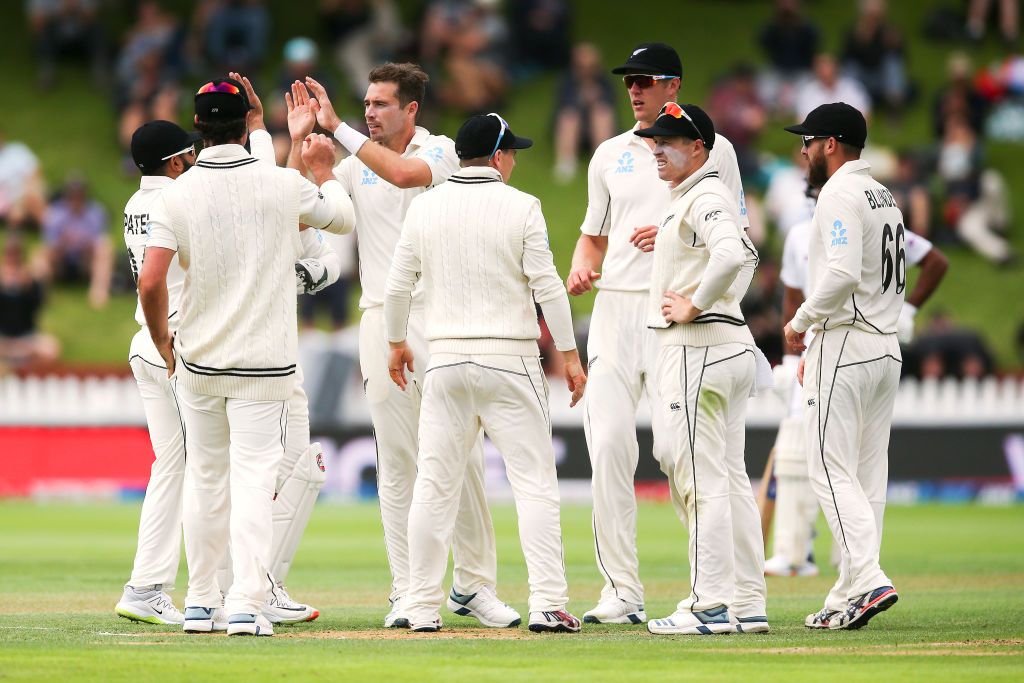The Gameplan | How New Zealand can tangle India in the World Test Championship final
While New Zealand might easily start the World Test Championship final as the favourites, it wouldn’t take much time before the tables turn, especially considering India’s cards. However, the BlackCaps will have to implement or mimic the following to tangle India for a famous ICC win.

Should Ajaz Patel sneak in ahead of Colin de Grandhomme?
A total of nine Tests against a total of 25 Tests - should New Zealand harvest their time and efforts in retaining Ajaz Patel or should they bring back their all-rounder Collin de Grandhomme? The facts are simple - an all-rounder to balance the side or a spinner to balance the bowling attack. If New Zealand decide to trust de Grandhomme, it would leave them with five pace bowling options, which in Southampton might be a gamble. However, not having the all-rounder would make their batting slightly weak. So what do they do?
Grandhomme hasn’t played a lot of Tests in England but so hasn’t Patel. In fact, both of them made their maiden Test appearance in England this tour, with Patel having the wood over the all-rounder. But what’s more important? Against India, across four innings, the all-rounder has picked up just two wickets, averaging 37. However, Patel has a batting average of 9.12 and a bowling average of 30.46. That should ideally eliminate his chances, right?
Ideally yes, but India have a terrible record against left-arm spinners, not entirely like England’s worries but alarming, nevertheless. Against left-arm spin, India have lost 32 wickets in the World Test Championship, only behind England and Zimbabwe in the list of most wickets lost. Jack Leach was a crucial figure in England’s Test series against India, picking up 18 wickets, at an average of 28.72. That’s where the talks of Ajaz Patel should bear in, especially considering that India have at least three batsmen - Rohit Sharma, Ajinkya Rahane and Cheteshwar Pujara - who have had their fair share of struggle against left-arm spinners. To add more, Moeen Ali was England’s hero last two times they played India, at the venue, just to set the context. For the batting part of it, New Zealand should be able to sneak away with Kyle Jamieson at No.7, after BJ Watling at No.6.
How can New Zealand tackle the Pant-sized problem?
Against Australia and England, India’s wicketkeeper-batsman Rishabh Pant showed what would happen to the result if he stayed not out. Out of the 33 innings that he has played for India, Pant has been dismissed 30 times, which isn’t really shocking, considering his intent. However, what is shocking is that he averages 45.26 at a strike rate of 71.47. Having never played Australia at home, Pant averages 62.40 while having an average of 39.27 against England, home and away. But there is one opposition, who has got Pant’s number - New Zealand.
Remarkably, the left-handed swashbuckling batsman only averages 15 against the BlackCaps, in four innings, with a high score of 25, with an under-par strike rate of 49.18. While he was run-out in the first innings in Wellington, he was undone by a Boult-er in the second. But that was an under-confident Pant, so how they do tackle him?
Three ways - one uber-aggressive, one aggressive and the other, Neil Wagner. So in hindsight, all three aggressive options, right? The first one, Ajaz Patel, fielders in the deep and a walking-into-trap Pant. The Indian batsman has just been dismissed once by a left-arm spinner, in the second innings of the second Test versus England against Jack Leach. It is indeed a high-risk high-reward technique, ask Leach. The second, New Zealand getting their traditional pacers to do the work, which happened in New Zealand. Bowling on slightly fuller of good length, the pacers got the left-hander to edge the delivery, a technique that has worked well.
The third, the most aggressive one, bowling Neil Wagner. Wagner does what no one can do, bounce the opposition out, with 49% of his deliveries being short-balls. In his short Test career, Pant has had his struggle against the short-ball, and the delivery, when well-executed, has accounted for his dismissal. New Zealand have two bowlers - Wagner and Jamieson - who can extract bounce and tangle the Indian batsman - to either play a false swipe or to pull it to the deep fielder, a ploy that has chances of working.
Will it be another easy-pass for New Zealand opening bowlers?
In the World Test Championship campaign, New Zealand have played just 11 Tests, out of which they have picked 39 wickets with the new ball, in the first 20 overs of an innings. Trent Boult and Tim Southee share the accolades, with 20 wickets as Kyle Jamieson is just behind with nine wickets of his own. That has been New Zealand’s way through to the final, bowling opposition out dead, with the new ball. While the Ageas Bowl isn’t overly tilted to favour the swing or seam bowlers, New Zealand’s approach has been that way, whereever they have travelled.
In comparison, Australia, England and India are the only three sides to take more wickets than New Zealand during the timeline. But they are playing India, a side that has always dominated up top. Or so we think so. That’s where the conception isn’t true, India have lost 37 wickets in the WTC season in the first 15-overs of the innings. During the same time, they have averaged just 31.22 with the bat, a phase that has hurt them. In the first 15 overs of the innings, barring Rohit Sharma, the India batsmen have a hard time tackling the new ball. Pujara averages 29.50, being dismissed four times, Kohli averaging 21.50 with two dismissals. Gill and Sharma on the other hand, average 45 and 34.8 but have been dismissed five times each.
Whichever, way, clear as daylight, India have struggled against the new ball, evident from their results in Adelaide and against New Zealand in both the Tests. With it being one of New Zealand’s strong facets, it might well be another point of a stronghold for the BlackCaps, against India.
What’s the best possible way to tackle Ravichandran Ashwin?
Quite simply, nothing. We would really be a set of liars if we called facing Ravichandran Ashwin easy - it is far from easy, perhaps, the toughest of challenges considering how he puts the conditions away in a jiffy. Against left-handers, Ashwin is as mighty as it can get in international cricket, on level with England’s Stuart Broad, both tied at 26 wickets. Ashwin’s average (14.42) and strike rate (38.46) makes him one of the best operators against left-handers and for New Zealand, it spells doom. In simple words, there is no real way out from Ashwin, as he seamlessly just finds his way out, by street-smartness or science, around the wicket or over the wicket, off-spin or leg-spin.
Against right-handers though, the average and the strike rate comes down, to 24.98 and 52.39, respectively. That’s where New Zealand would have to be street-smart, on their own. The left-handers - Devon Conway, Tom Latham and Henry Nicholls - have to make their life easier with their non-striker and the non-striker’s end against Ashwin. There is no real way out for them, considering that the Indian off-spinner just finds new scientific ways of getting the ball to do a boomerang. The only tip that would help them? Get to the non-striker’s end and leave it to the right-handers to take care.
The introduction of Kyle Jamieson
The entry point of Kyle Jamieson has been rather weird, considering the fact that most of his Tests, actually all of it in the World Test Championship, have come at home. Before the series against England, Jamieson had just bowled a grand of five overs in the first ten overs of an innings, picking up one wicket, averaging 11. However, the phases after that are where he is arguably the most successful, with 8 wickets in 11-20, 7 wickets in 21-40.
But his record, against Virat Kohli and Cheteshwar Pujara - two of India’s strongholds - is exceptional, which makes his entry-point extremely crucial. In both the Tests, Jamieson showed that he could not only walk in as the third seamer in this four-man pace attack but also proved that he could get the ball to do stuff, even when it is 30-40 overs old. Now that’s where we are going to make an interesting comparison - Ollie Robinson. It is not just based on height but the two bowlers have a similar approach to their bowling, release points and lengths. And, more often than not, they hit the stumps.
In the first Test, rather the only Test he has played thus far, Robinson came to bowl in the 9th over of the innings - an indication of how the new-ball would surface on flatter wickets, like the one at Lord’s. New Zealand should have a similar approach with Jamieson with the presence of both Boult and Southee. Walking into bowl in the 9th over of the innings, would not just be useful for Jamieson, in terms of his natural strength, a phase where he has found success, it would also allow for the BlackCaps to have more control over the proceedings. But all of it, only on pen and paper.

Comments
Sign up or log in to your account to leave comments and reactions
0 Comments